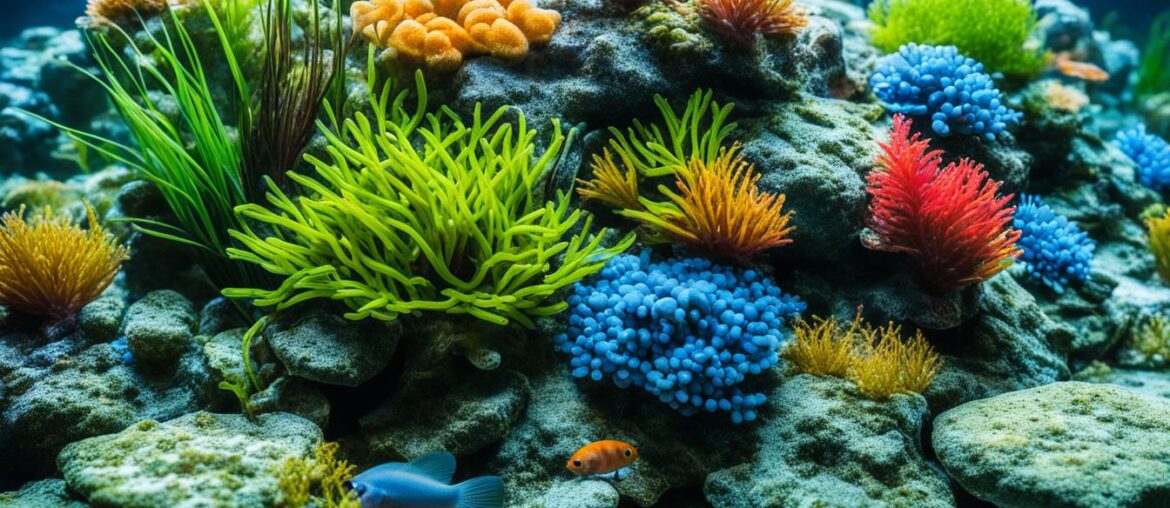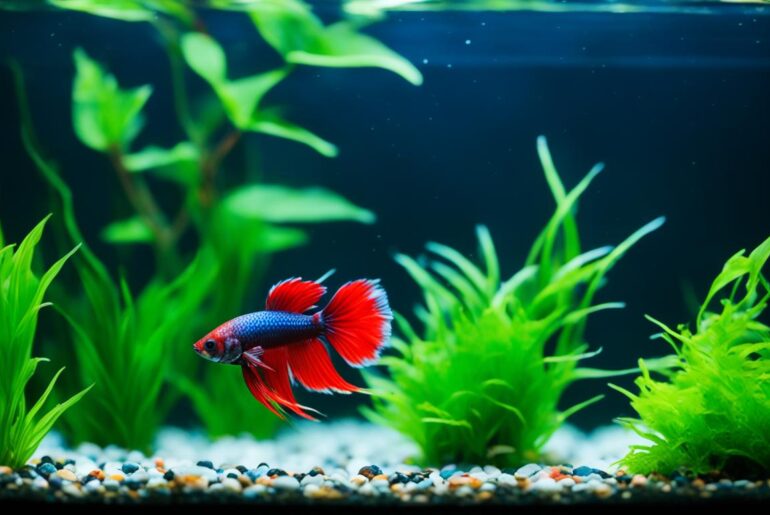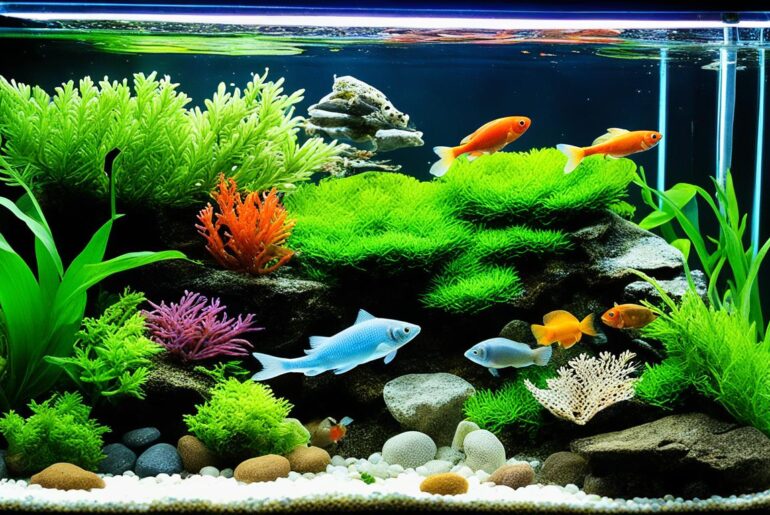Have you ever wondered what it takes to breed freshwater invertebrates at home? It’s a fascinating process that allows you to witness the miracle of life up close. But where do you even begin? Is it difficult? What are the secrets to success?
In this article, I will guide you through 10 steps that will help you breed freshwater invertebrates at home successfully. We will explore everything from setting up the ideal breeding environment to choosing the right species and providing proper nutrition. Whether you’re a beginner or an experienced hobbyist, these steps will set you on the path to success.
Key Takeaways:
- Creating the ideal breeding environment is crucial for successful freshwater invertebrate breeding.
- Choosing the right species is important for your breeding goals and interests.
- Maintaining optimal water parameters is essential for the health and breeding success of freshwater invertebrates.
- Providing proper nutrition is crucial for the health and breeding success of freshwater invertebrates.
- Creating hiding places and shelters promotes breeding success and provides protection for the invertebrates.
Setting Up the Ideal Breeding Environment
Creating the ideal breeding environment is crucial for the successful breeding of freshwater invertebrates. To ensure their comfort and safety, it’s important to set up the right tank with proper water parameters and an efficient filtration system.
When it comes to invertebrate tank setup, there are a few key factors to consider:
- Tank Size: The size of the tank will depend on the species and the number of invertebrates you plan to breed. Make sure to provide enough space for the invertebrates to swim and explore.
- Substrate: Choosing the right substrate is essential for the invertebrates’ well-being. Some invertebrates prefer sand or gravel, while others thrive on a bare bottom tank.
- Decorations: Adding plants, rocks, or driftwood to the tank provides hiding spots and shelters for the invertebrates. These hiding places are crucial for their breeding and molting processes.
- Lighting: Invertebrates have different lighting preferences. Research the specific lighting requirements of the species you plan to breed and provide them with the appropriate intensity and duration of light.
Water parameters for invertebrate breeding play a crucial role in their overall health and breeding success. Here are some important factors to consider:
“Creating the ideal breeding environment requires careful attention to water parameters to provide the invertebrates with the perfect conditions for breeding.”
| Water Parameter | Ideal Range | Notes |
|---|---|---|
| pH | 6.5-8.0 | The pH level should be within the acceptable range for the specific species. |
| Water Hardness | 5-15 dGH | Ensure that the water hardness meets the requirements of the invertebrates. |
| Temperature | Varies by species | Each species has its own preferred temperature range. Research the specific requirements for your chosen invertebrate species. |
Choosing the right filtration system is also essential for maintaining optimal water quality in the breeding tank. Consider the following options:
- Sponge Filters: Sponge filters are gentle and provide biological and mechanical filtration for the tank. They are ideal for small to medium-sized breeding setups.
- Canister Filters: Canister filters offer efficient mechanical and chemical filtration. They are suitable for larger breeding setups with a higher bioload.
- Hang-On-Back (HOB) Filters: HOB filters are easy to install and maintain. They provide adequate filtration for smaller breeding tanks.
Remember to regularly monitor and maintain your breeding environment to ensure the health and well-being of your invertebrates. Now that the ideal breeding environment is set up, let’s move on to the next section to learn about choosing the right species for breeding.
Choosing the Right Species for Breeding
When it comes to breeding freshwater invertebrates at home, selecting the right species is crucial for success. Not all species are equally easy to breed or profitable, so it’s important to do your research and choose wisely. Here are a few factors to consider when selecting the best invertebrate species for your breeding project:
- Popular Freshwater Invertebrate Species: Start by exploring the most popular freshwater invertebrate species that enthusiasts commonly breed. This includes creatures like Cherry Shrimp, Red Cherry Shrimp, and Amano Shrimp.
- Easy-to-Breed Invertebrates: Some species are easier to breed than others. Beginner breeders might find success with hardy and resilient species like Ghost Shrimp or Ramshorn Snails.
- Profitable Invertebrate Breeding: If your goal is to turn your breeding venture into a profitable enterprise, consider species sought after by hobbyists and collectors. This could include specialty shrimp varieties like Crystal Red Shrimp or exotic snail species like Assassin Snails.
Remember to take into account your own interests and breeding goals. Choose species that you find fascinating and enjoyable to breed. This will increase your motivation and make the breeding process even more rewarding.
Here are some popular freshwater invertebrates you can consider:
| Invertebrate | Difficulty Level | Profitability |
|---|---|---|
| Cherry Shrimp | Easy | Low to Medium |
| Amano Shrimp | Moderate | Low |
| Ghost Shrimp | Easy | Low |
| Crystal Red Shrimp | Moderate | High |
| Assassin Snail | Easy | Medium |
Keep in mind that these are just a few examples, and there are many more species to explore and choose from. Take the time to research each species you are interested in, including their care requirements, breeding conditions, and compatibility with other tank mates.
Now that you have a better understanding of choosing the right species, let’s move on to the next section: Maintaining Optimal Water Parameters.
Maintaining Optimal Water Parameters
When it comes to breeding freshwater invertebrates, maintaining optimal water parameters is crucial for their successful reproduction. Different species have specific requirements, but there are some common factors that need to be considered, including pH levels, water hardness, and temperature.
1. pH levels: The ideal pH range for invertebrate breeding varies depending on the species. It is important to research the specific pH requirements of the invertebrates you are breeding. Monitoring and adjusting the pH levels accordingly will help ensure a suitable breeding environment.
2. Water hardness: Invertebrates have different preferences when it comes to water hardness. Some species thrive in soft water, while others prefer harder water. Understanding the water hardness requirements of your invertebrates will contribute to their successful breeding. Consider testing your water hardness regularly and making adjustments if needed.
3. Temperature: Temperature plays a vital role in the breeding success of freshwater invertebrates. Each species has its own temperature range within which breeding is optimal. It is essential to provide a stable and suitable temperature in the breeding tank to encourage reproduction. Research the specific temperature requirements of your invertebrates and use a reliable aquarium heater to maintain the desired temperature.
“Maintaining optimal water parameters is like laying the foundation for successful invertebrate breeding. By creating an environment that mimics their natural habitat, we can encourage these remarkable creatures to thrive and reproduce.”
To help you understand the different water parameter requirements of some common freshwater invertebrate species, here is a table summarizing their ideal pH levels, water hardness, and temperature:
| Freshwater Invertebrate Species | Ideal pH Range | Preferred Water Hardness | Optimal Temperature |
|---|---|---|---|
| Cherry Shrimp (Neocaridina davidi) | 6.5 – 8.0 | 2 – 10 dKH | 72 – 82°F (22 – 28°C) |
| Crystal Red Shrimp (Caridina cantonensis) | 5.5 – 7.0 | 0 – 4 dKH | 68 – 78°F (20 – 26°C) |
| Amano Shrimp (Caridina multidentata) | 6.5 – 7.5 | 3 – 10 dKH | 73 – 81°F (23 – 27°C) |
| Ghost Shrimp (Palaemonetes paludosus) | 6.5 – 8.0 | 2 – 12 dKH | 65 – 80°F (18 – 27°C) |
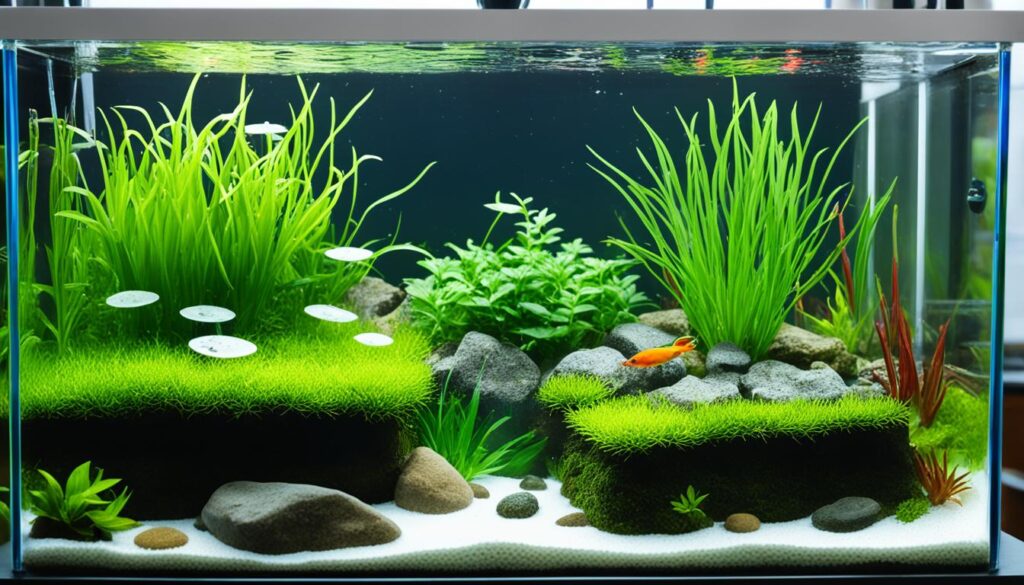
Remember, maintaining optimal water parameters is just one aspect of creating a suitable breeding environment for freshwater invertebrates. It is crucial to research and understand the specific requirements of the species you are breeding to ensure their overall well-being and successful reproduction.
Providing Proper Nutrition
Proper nutrition is crucial for the health and breeding success of freshwater invertebrates. These fascinating creatures have specific dietary needs that must be met to ensure their well-being. Feeding freshwater invertebrates requires a deep understanding of their natural diet and nutritional requirements.
Researching the dietary requirements of the invertebrate species you are breeding is essential. Different species may have distinct feeding preferences, so it’s crucial to provide them with the appropriate food sources. Many freshwater invertebrates thrive on live foods, such as small insects, crustaceans, and worms. These live foods not only provide essential nutrients but also stimulate natural feeding behaviors.
Invertebrate diet should consist of a variety of nutritious live foods that mimic their natural prey. Here are some common live foods that are suitable for feeding freshwater invertebrates:
- Daphnia: These tiny aquatic crustaceans are excellent sources of protein and are a favorite food for many freshwater invertebrates.
- Brine shrimp: Rich in protein and essential fatty acids, brine shrimp are often used as a staple food for various invertebrates.
- Microworms: These small nematodes are a nutritious food source and are particularly suitable for feeding young or small invertebrates.
- Wingless fruit flies: Fruit flies are rich in protein and can be an excellent food source for small or juvenile invertebrates.
While live foods are essential for invertebrates, it’s also crucial to offer a balanced diet. Supplementing live foods with high-quality commercial invertebrate diets can ensure that your freshwater invertebrates receive a complete range of nutrients. These specialized diets are formulated to meet the nutritional needs of various invertebrate species and can be an excellent addition to their diet.
Remember to observe your invertebrates’ feeding behaviors and adjust their diet accordingly. Monitoring their growth, coloration, and overall health can help determine if their nutritional needs are being met. Regularly provide a variety of food sources and ensure that they are appropriately sized for your invertebrates to consume.
Creating a balanced and appropriate diet for your freshwater invertebrates is crucial for their well-being and breeding success. By understanding their specific dietary requirements and providing a varied and nutritious menu, you can ensure the optimal health and growth of your invertebrate colony.
Creating Hiding Places and Shelters
When it comes to breeding freshwater invertebrates, creating hiding places and shelters in the breeding tank is essential for their breeding success. These hiding places provide a sense of security and protection, particularly during critical stages like molting and breeding.
One effective way to provide hiding places and shelters for your invertebrates is by adding tank decorations. Rocks, plants, and caves are all excellent options that mimic natural habitats and offer invertebrates a safe space.

Decorative rocks can provide hiding spots and create interesting crevices for your invertebrates to explore. Ensure that the rocks you choose do not have sharp edges and are large enough to prevent accidental trapping.
“Adding live plants to your aquarium not only enhances its aesthetic appeal but also provides natural hiding places for invertebrates. Plants like Java moss, Anubias, and Hornwort allow invertebrates to seek shelter and feel safe.”
Caves are another popular choice for creating breeding shelters. You can find pre-made caves or create your own using materials like PVC pipes, ceramic tubes, or coconut shells. These dark and enclosed spaces offer invertebrates a secluded environment where they can breed and take refuge.
In addition to providing hiding places and shelters, it is crucial to consider the layout and arrangement of your tank decorations. Creating a diverse and natural-looking habitat will encourage invertebrates to explore and utilize the hiding places you have provided.
Tank Decorations for Invertebrates
| Decoration | Description |
|---|---|
| Rocks | Natural and safe hiding spots for invertebrates; avoid sharp edges. |
| Live Plants | Provide hiding places and add visual appeal to the aquarium; Java moss, Anubias, and Hornwort are great options. |
| Caves | Dark and enclosed spaces that offer breeding shelters for invertebrates; PVC pipes, ceramic tubes, and coconut shells can be used. |
By creating suitable hiding places and shelters, you are providing a conducive environment for the breeding and overall well-being of your freshwater invertebrates. Remember to carefully choose tank decorations that meet the specific needs of the species you are breeding and consider incorporating a variety of hiding places to cater to diverse invertebrate preferences.
Breeding Techniques and Strategies
Successful breeding of freshwater invertebrates relies on understanding their unique breeding techniques and strategies. Different species exhibit various reproductive behaviors and have distinct breeding cycles. To ensure successful breeding, it is crucial to research and implement appropriate techniques and strategies based on the specific invertebrate species you are breeding.
By gaining knowledge about invertebrate breeding behavior, you can create an environment that encourages successful reproduction. It is important to provide the ideal conditions for breeding to occur, such as the optimal water parameters, temperature, and hiding places.
Understanding the reproductive behaviors of freshwater invertebrates allows you to anticipate and respond to their needs effectively. Some invertebrates undergo complex courtship rituals, while others rely on specific environmental cues to trigger breeding.
A comprehensive understanding of the breeding techniques and strategies of the invertebrate species you are working with enables you to provide the best possible conditions for successful breeding. Research the specific requirements, behaviors, and reproductive cycles of the species you are breeding to optimize your breeding efforts.
Below are some key elements to consider when implementing breeding techniques and strategies:
- Specific environmental conditions required for breeding
- Courtship behaviors and rituals
- Reproductive cycles and timing
- Egg-laying and fertilization processes
- Incubation and hatching methods
- Parental care behaviors, if applicable
Applying these techniques and strategies will increase your chances of successful breeding and the production of healthy offspring. It is important to be patient and observant during the breeding process, making adjustments as necessary to meet the needs of your invertebrates.
Expert Tips:
“To enhance breeding success, mimic natural conditions as closely as possible. Research the specific breeding behavior and requirements of your chosen invertebrate species, and recreate their natural habitat within your breeding tank.”
– Dr. Emily Thompson, Aquatic Biologist
In the next section, we’ll discuss the importance of monitoring and managing breeding conditions to ensure the health and success of your freshwater invertebrates.
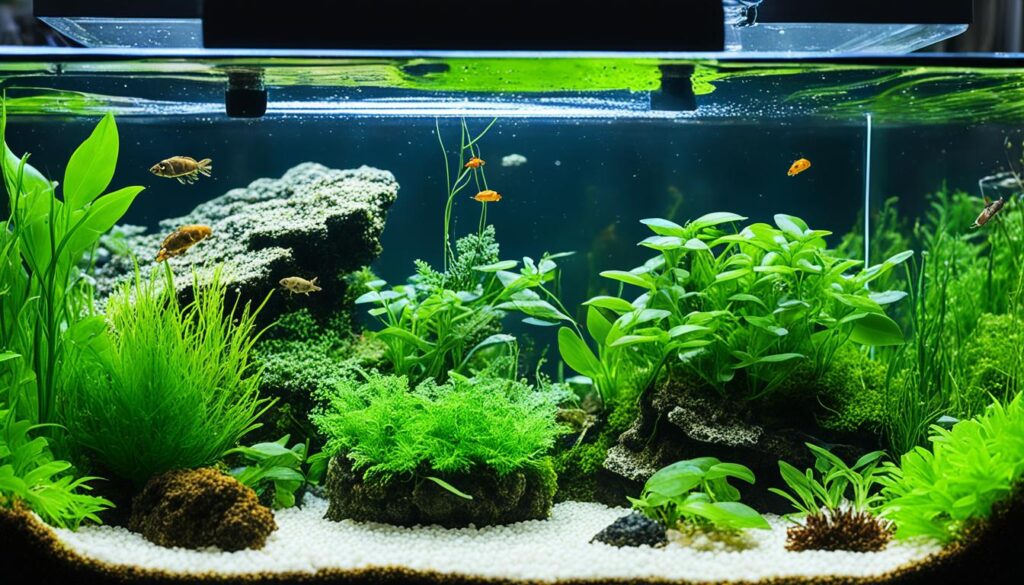
Monitoring and Managing Breeding Conditions
Monitoring and managing breeding conditions is vital for the health and success of your breeding freshwater invertebrates. By regularly checking water parameters, monitoring breeding behavior, and conducting necessary maintenance tasks such as water changes and filter cleaning, you can create an optimal environment for your invertebrates to thrive.
Keeping a close eye on the breeding conditions allows you to identify any issues or problems early on, and take appropriate actions to address them. This proactive approach can significantly increase the chances of successful breeding and ensure the well-being of your invertebrates.
Regular Water Quality Testing
One essential aspect of monitoring breeding conditions is conducting regular water quality testing. Water quality directly impacts the health and breeding success of freshwater invertebrates. By testing parameters such as pH, ammonia, nitrate, nitrite, and temperature, you can ensure that the water remains within the appropriate range for your invertebrates.
| Water Parameter | Ideal Range |
|---|---|
| pH | 6.5 – 8.5 |
| Ammonia | 0 ppm |
| Nitrate | 0 – 20 ppm |
| Nitrite | 0 ppm |
| Temperature | Dependent on species |
Regular water quality testing will help you identify any fluctuations or abnormalities in the water parameters, allowing you to take corrective measures promptly. It is essential to prioritize the health and well-being of your invertebrates by maintaining optimal water conditions for their breeding success.
Observing Breeding Behavior
Observing and monitoring the breeding behavior of your freshwater invertebrates is another key component of managing breeding conditions. By closely watching their behavior, you can identify signs of breeding activity, territorial disputes, or any unusual behavior that may indicate stress or illness.
It is beneficial to familiarize yourself with the typical breeding behavior of the invertebrate species you are breeding. This knowledge will enable you to differentiate between normal behavior and potential problems. Promptly addressing any issues can help maintain a healthy breeding environment and maximize your chances of successful breeding.
Maintenance Tasks
Regular maintenance tasks are crucial for managing breeding conditions effectively. Performing tasks such as regular water changes, filter cleaning, and equipment inspection helps maintain optimal water quality, ensures efficient filtration, and prevents the buildup of waste or harmful substances.
Water changes should be conducted according to the specific needs of your invertebrates. While some species may benefit from frequent partial water changes, others may require more stable conditions with fewer disruptions. Understanding the requirements of the species you are breeding will guide you in determining the appropriate water change schedule.
Cleaning the filtration system is essential to prevent the accumulation of debris and maintain the efficiency of the filtration process. Regularly inspecting equipment, such as heaters and air pumps, ensures they are functioning correctly and pose no risks to your invertebrates.
By diligently performing these maintenance tasks, you can create a clean and stable environment that promotes successful breeding and supports the overall well-being of your freshwater invertebrates.
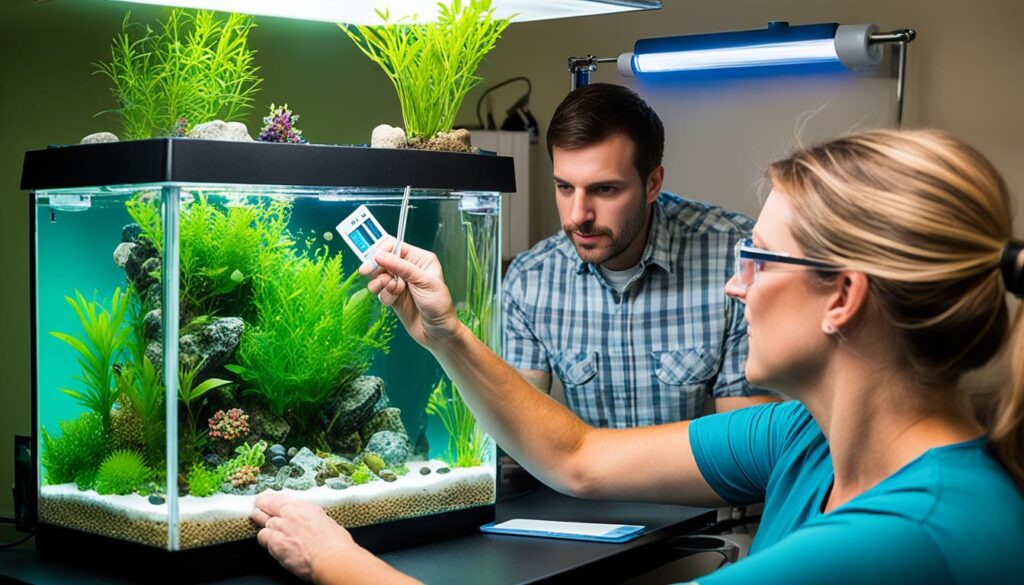
Troubleshooting Common Breeding Problems
While breeding freshwater invertebrates can be a fascinating hobby, it’s not without its challenges. To ensure successful breeding, it’s crucial to understand common breeding problems and know how to troubleshoot them. Some issues you may encounter include low breeding success, poor survival rates, or health problems. By familiarizing yourself with common problems associated with the species you are breeding, you can take proactive steps to address them effectively.
To troubleshoot invertebrate breeding problems, I recommend the following techniques:
- Monitor water parameters: Regularly check and maintain the appropriate water parameters for the species you are breeding. Inconsistent water quality can negatively impact breeding success.
- Review feeding regimen: Assess the nutritional requirements of your invertebrates and ensure they are receiving a balanced diet. Adjust the feeding schedule or provide additional food sources if necessary.
- Identify potential stressors: Identify any potential stressors in the breeding environment, such as aggressive tank mates or inadequate hiding places. Take steps to minimize stress and create a safe and comfortable environment for your invertebrates.
- Observe breeding behavior: Carefully observe the behavior of your invertebrates during the breeding process. Look for signs of aggression, stress, or abnormalities that may hinder successful breeding. Make adjustments to the breeding setup based on your observations.
- Consider water quality: Poor water quality can adversely impact breeding and the overall health of your invertebrates. Regularly test the water parameters and perform necessary water changes or filtration system maintenance to maintain optimal conditions.
If you are still facing difficulties in breeding your freshwater invertebrates, don’t hesitate to seek advice from experienced hobbyists or consult reputable online sources. Remember that each species may have unique requirements, so it’s essential to tailor your troubleshooting efforts according to their specific needs.
By addressing common breeding problems promptly and utilizing effective troubleshooting techniques, you can increase your chances of successful breeding and enjoy the wonders of freshwater invertebrate breeding.
Conclusion
Breeding freshwater invertebrates at home can be a rewarding and fulfilling experience. By following the 10 steps outlined in this article, you can increase your chances of successful breeding and enjoy the beauty of these fascinating creatures in your home.
Remember to always research and understand the specific requirements of the invertebrate species you are breeding, and be patient and persistent in your breeding efforts. Each species has its own unique needs and behaviors, so it’s important to tailor your care to their specific requirements.
With proper care and attention to detail, you can create a thriving breeding environment and witness the amazing journey of invertebrates reproducing and developing their young. Not only will you gain satisfaction from successfully breeding these creatures, but you will also contribute to the conservation and preservation of various freshwater invertebrate species. Your efforts can make a positive impact on their populations, both in the aquarium hobby and in nature.
Good luck with your freshwater invertebrate breeding journey! Enjoy the excitement of watching new life unfold before your eyes and take pride in being a part of the intricate world of invertebrate breeding. Happy breeding!
FAQ
What are the 10 steps to breeding freshwater invertebrates at home successfully?
The 10 steps to breeding freshwater invertebrates at home successfully include creating the ideal breeding environment, choosing the right species for breeding, maintaining optimal water parameters, providing proper nutrition, creating hiding places and shelters, understanding breeding techniques and strategies, monitoring and managing breeding conditions, troubleshooting common breeding problems, being patient and persistent, and enjoying the experience.
How should I set up the ideal breeding environment for freshwater invertebrates?
To set up the ideal breeding environment for freshwater invertebrates, you need to ensure you have the right tank, proper water parameters, and a suitable filtration system. Additionally, providing hiding places and shelters for the invertebrates is important for their breeding success.
How do I choose the right species for breeding freshwater invertebrates at home?
You can choose the right species for breeding freshwater invertebrates by researching popular species, considering their ease of breeding and profitability, and selecting the ones that align with your interests and breeding goals.
What water parameters should I maintain for successful breeding of freshwater invertebrates?
Maintaining optimal water parameters is crucial for the successful breeding of freshwater invertebrates. Factors to consider include pH levels, water hardness, and temperature. It is important to research the specific requirements of the invertebrate species you are breeding and ensure that the water parameters are within the appropriate range.
What should I feed my freshwater invertebrates for proper nutrition?
It is essential to provide proper nutrition to freshwater invertebrates for their health and breeding success. Different species have different dietary needs, so it is important to research the specific requirements of the species you are breeding. This may involve feeding them live foods or specialized diets.
How can I create hiding places and shelters in the breeding tank for freshwater invertebrates?
You can create hiding places and shelters in the breeding tank for freshwater invertebrates by adding tank decorations such as rocks, plants, and caves. These hiding places provide protection and security for the invertebrates, especially during molting and breeding.
What breeding techniques and strategies should I be aware of for freshwater invertebrates?
Different species of freshwater invertebrates may have different reproductive behaviors and breeding cycles. It is important to research the specific breeding techniques and strategies for the invertebrate species you are breeding and provide the appropriate conditions to promote successful breeding.
How should I monitor and manage the breeding conditions for freshwater invertebrates?
Monitoring and managing breeding conditions is important to ensure the health and success of your breeding freshwater invertebrates. This involves regularly checking water parameters, monitoring breeding behavior, and performing necessary maintenance tasks such as water changes or filter cleaning.
What are some common breeding problems I may encounter when breeding freshwater invertebrates?
Common breeding problems when breeding freshwater invertebrates may include low breeding success, poor survival rates, or health issues. It is important to research common problems associated with the species you are breeding and learn effective troubleshooting techniques to overcome these challenges.
Is breeding freshwater invertebrates at home a rewarding experience?
Yes, breeding freshwater invertebrates at home can be a rewarding and fulfilling experience. By following the 10 steps outlined in this article and being patient and persistent, you can increase your chances of successful breeding and enjoy the beauty of these fascinating creatures in your home.
